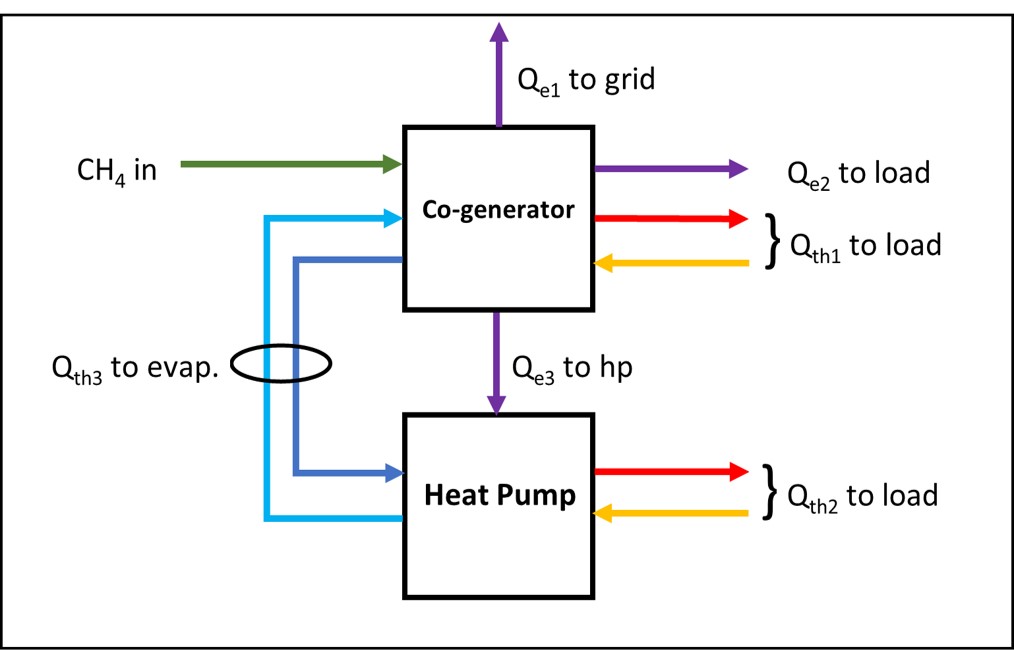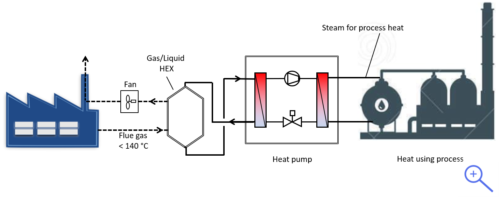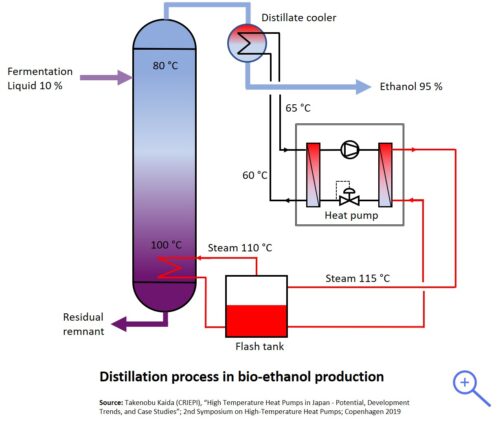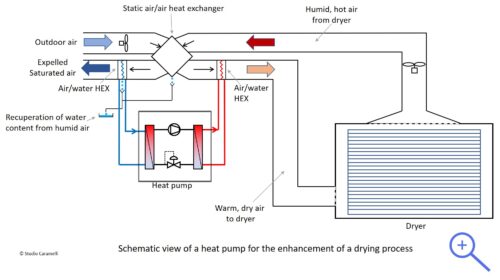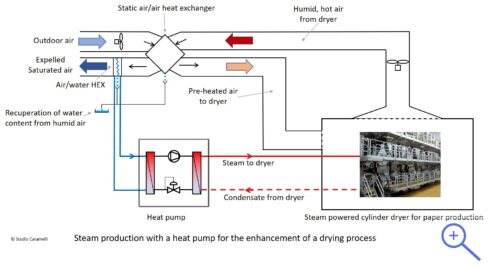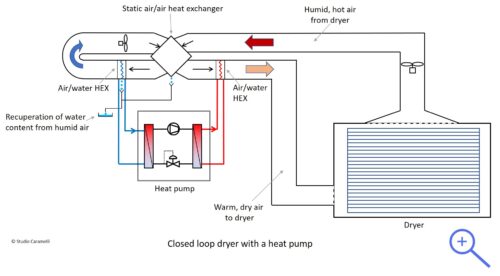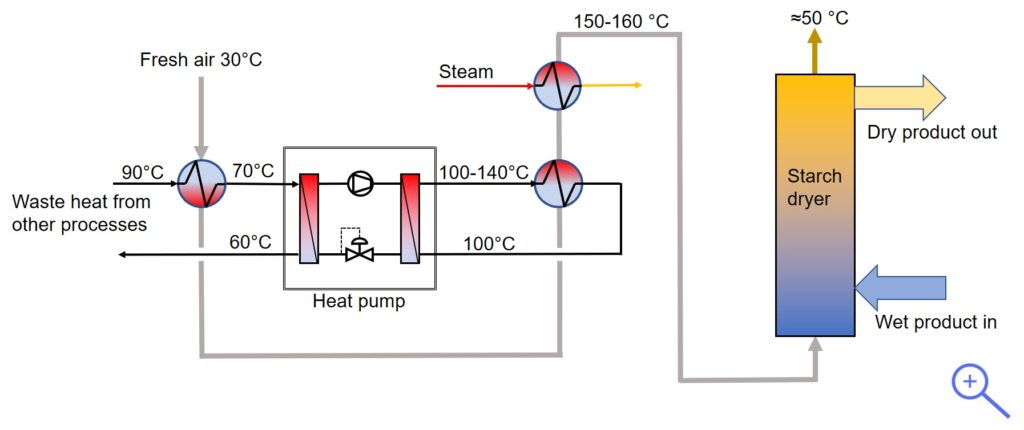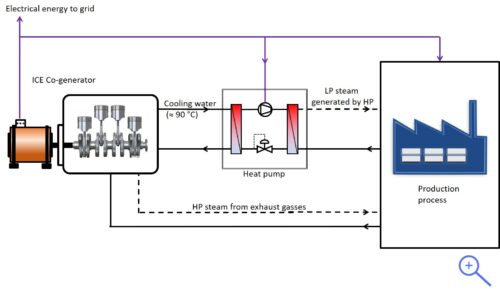industrial heat pumps
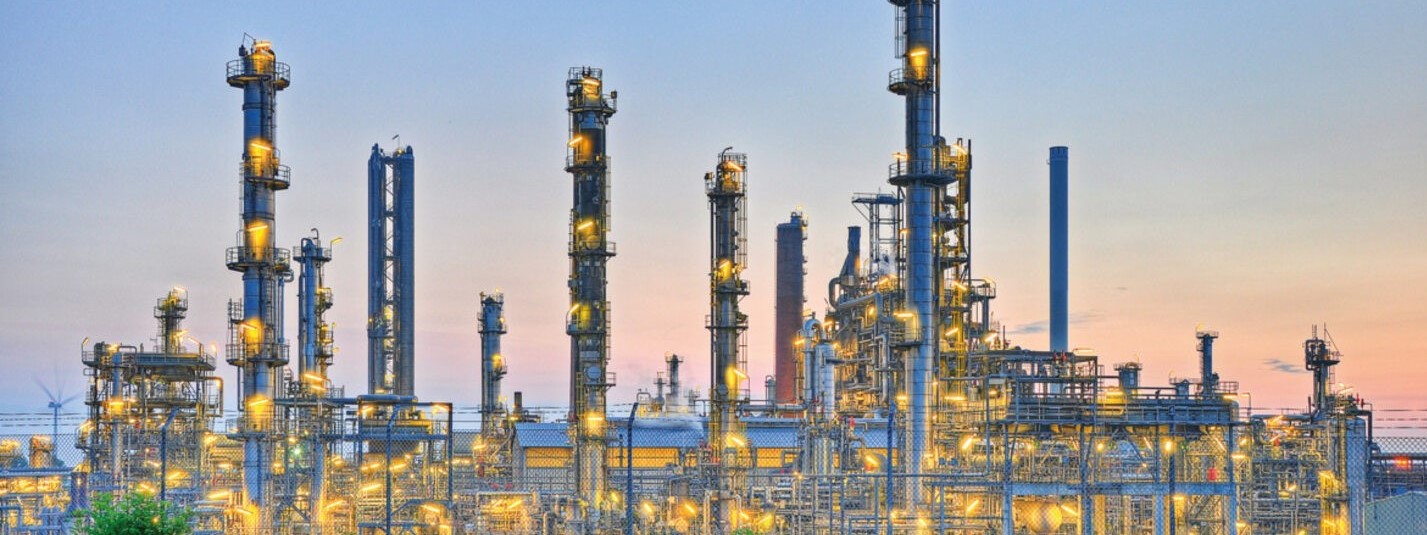
applications of heat pumps in industry
introduction
To evaluate the economic and environmental advantages of a heat pump for a specific application, it is essential to be very much aware that their energy performance depends strongly on the characteristics of the thermal system downstream. In particular the temperature at which the heat must be supplied (the condenser outlet temperature) and the temperature at which waste heat for the evaporator is available (the evaporator inlet temperature) are critical parameters which define the COP and the thermal output. Another important element to consider is the coincidence of the availability of the waste heat with the demand for heat from the customer system. Short time differences between the two ( e.g. less than 2-3 days) can be bridged by a thermal storage devices. Longer gaps may become problematic.
So, the condenser outlet temperature, the evaporator inlet temperature and the load profile are the three parameters which can ‘make or break’ the heat pump performance. In this respect, a heat pump is fundamentally different from a heat generator powered by fossil fuels. A traditional heat generator can be used with good efficiency over a wide range of temperatures and has no time constraints while for heat pumps this is clearly not the case.
All this makes that in order to obtain the best results, the integration of a heat pump with the thermal system downstream, has to be analysed seperatly for every case. For complex thermal systems it might be necessary to proceed with a Pinch Analysis (see also: Pinch Analysis). Studio Caramelli S.r.l. can assist it clients with the analysis for a correct integration of heat pumps.
the production of low pressure steam
Steam is a vital resource for many industrial activities. In addition to its use for electricity generation, steam is widely used in many SMEs as a carrier for thermal enrgy, for example for:
- Pasteurization
- Starch drying
- Breweries
- Sugar production
- Pharmaceutical industry (sterilization)
- Laundries
- Food and beverages
- Drying process
- Chocolate production
- Paper production
- Cleaning
- Chemical industry… and many more
An overview of industrial processes using thermal energy and the temperature levels involved can be found here.
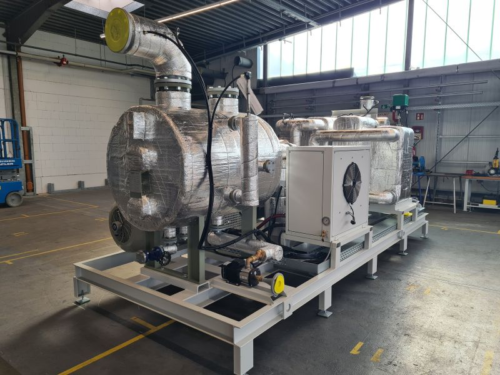
One of the most interesting features of the ThermBooster™ made by SPH Sustainable Process Heat GmbH is the possibility of producing steam without using fossil fuels. This allows for the production of clean, carbon-free steam in a much more efficient way than electric steam generators can.
On request, the ThermBooster™ can be supplied with a condenser capable of producing steam. In this way, by avoiding a separate steam generator (less costs!) one can obtain higher steam pressures while maintaining the performance of the heat pump at the same level (COP and heat output). Graphs illustrating the performance of the ThermBooster™ for the production of steam, are available here.
example of steam production with a heat pump
A considerable share of all fossil energy used, is lost through chimneys. This loss of useful energy can be reduced by cooling the fumes to temperatures closer to those of the environment, before their expulsion into the air. If there is no need heat demand for similar low temperatures, a heat pump can be used to cool the fumes and produce steam which might be useful. A heat pump is the perfect tool for doing this, as illustrated in the figure to the left. Obviously, this solution is not limited to the recovery of energy from stack gasses but can be applied in all cases where there is a flow of thermal energy available. In order to avoid corrosion problems in the gas/liquid exchanger, the exhaust gasses must be analysed and when necessary, protective measures should be taken.
An example of using flue gas as a heat source for a heat pump in an Austrian dairy can be found here.
distillation processes
Distillation is the most widely used separation technology in the chemical industry and is responsible for over 40% of energy consumption in this sector. The process has many benefits and is widely used. The main drawback of distillation is its high use of energy. In fact, in the chemical industry, the cost of energy for distillation can be over 50% of the plant’s operating costs.
A heat pump can increase the temperature level of the thermal energy released by the condenser of the distillation column and make it suitable again for powering the reboiler (see figure below). In this manner the energy requirement of the distillation process is reduced very significantly.
For this reason, powering a distillation processes is a frequent application of heat pumps in the chemical industry.
heat pumps in distillation processes
The distillation process has a relatively low thermodynamic efficiency and requires the injection of high quality thermal energy into the reboiler to power the separation process. At the same time, a similar amount of heat, but at lower temperatures, must be extracted from the condenser. Many distillation processes require relatively modest temperature increases (see table). The fact that the reboiler temperature and the condensor temperature are often rather close and the fact that the energy balance on the column is almost in equilibrium, makes the heat pump a particularly suitable tool for feeding distillation processes.
The figure on the right illustrates in a generic way, how a heat pump can be applied in a distillation process.
Heat pumps using closed loops and mechanical vapor compression cycles, can be easily integrated into existing distillation plants, often without any need to change the distillation column or the parameters of the process itself.
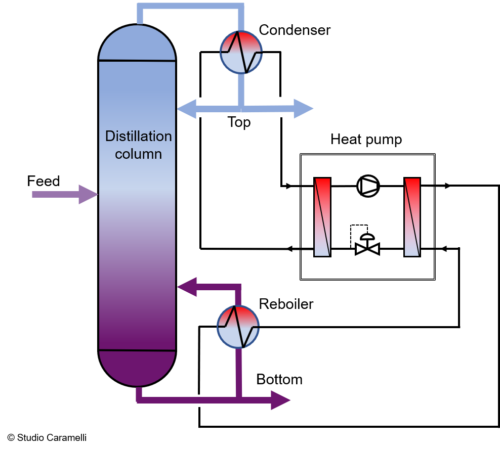
With the latest generation of compressors and refrigerants for heat pumps, temperatures increases of up to 60 °C are possible and thermal energy for the reboiler can be supplied up to 160 °C. The use of a heat pump to power the distillation processes can lead to very significant primary energy savings, in some cases up to 80% (see table).
distillation of bioethanol
The figure on the left side shows the diagram of a bioethanol distillation plant, which is operational since 2012, in Japan (source: Kaida 2019). The plant consists of five, two-stage heat pumps. Each machine has two screw compressors and uses R245fa as refrigerant. The machines produce about 2 t/hr of steam at about 120 ° C. The COP of the heat pump is 3,5.
Drying processes
Drying is an very energy-intensive process, which, in most developed countries, accounts for around 10 – 20 % of the total energy consumption in industry. For example, drying processes in the agri-food industry, in laundries, in wood dryers, in paper mills, etc. are particularly energy-intensive. The main reason for this high energy consumption is the need to provide the latent heat, necessary for the evaporation of water or other solvents. The temperatures used for these processes are generally between 80 and 250 °C.
Opportunities to reduce energy consumption are:
1) Reduce the amount of water to be evaporated, for example by pressing the product to be dried, before the thermal drying process.
2) Increase the efficiency of the dryer, for example:
- by increasing the thermal insulation of the dryer,
- by reducing heat losses through ventilation by installing a heat recovery unit in the ventilation ducts,
- by changing the operating parameters of the dryer.
3) Improve the energy supply system, for example by increasing the efficiency of the heat generator or by using combined heat and power (CHP). Better still, use a heat pump. In this way most of the thermal energy used for the evaporation of the water, can be recovered, as illustrated in the figures below.
how can a heat pump be used for drying
The figure on the right side shows schematically how a heat pump can be used to make an industrial open cycle drying process more energy efficient.
A heat pump allows not only to recover a very significant part of the thermal energy used by the drying process, but also water contained in the humid flow at the outlet of the dryer can recuperated through condensation. In this manner the water consumption of the production process can be reduced.
Recovery through direct exchange is less expensive from an economic and environmental point of view and should therefore be favoured as is illustrated in the diagram.
The temperature at the outlet of the condenser defines if and how munch auxiliary energy must be used in order to bring the air flow at the temperature required by the process. A high temperature of the condenser inevitably leads to a lower COP and less heat output. Therefore it is necessary to carefully optimize the system during for getting the best result from an economic/environmental point of view.
drying and vapour production
In certain drying processes, for example in the paper industry, most of the energy required for evaporation is not supplied via the ventilation air but by steam. In these cases, the heat pump can be used to produce steam (up to 6 bar) by recuperating the energy available in the flow of saturated air, which is expelled by the dryer. This steam can be used for heating the cylinders in the dryer, as shown in the figure on the right.
closed loop dryer
For various reasons it is not always possible or efficient, to expel the exhaust air to the outside. In these cases a closed cycle drying process is used. The figure on the left shows the configuration of such a process in a schematic way. In these case the ventilation air should be cooled in order to eliminate the water from the dryer.
starchdrying
The flow diagram of a thermal energy recovery system in a starch drying process is shown on the right. In this process, the air used in the dryer is heated in three stages:
- direct exchange with a waste heat flow (in this case water at 90 °C from another process).
- heating via the heat pump.
- final heating with steam.
It should be noted that the waste heat is recovered through a direct heat exchange first, and only after when the direct heat exchange if is fully exploited, a part of the residual heat in the water flow is recuperated with the help of the heat pump for the second stage of heating.
In the event that there is no water flow from which heat can be recuperated, the flow of humid air at the outlet of the dryer can be used as a heat source for the evaporator.
This heat pump assisted drying concept can serve as a model for many drying processes.
the combination of a cogenerator and a heat pump
Co-generators with internal combustion engines (ICE) have the drawback that about half of the thermal energy produced has a temperature below 100 °C. This feature makes the use of these machines less interesting for industries that only use steam. Furthermore, the production of electricity frequently exceeds the needs of the site where the co-generator is located and therefore a significant part of this energy is fed into the grid, which often yields a rather low financial return.
High temperature heat pumps can mitigate both problems. Since they can upgrade heat available at temperatures below 100 °C, into steam up to 6 bar and can use for this process the excess of electricity produced by the co-generator.
The conceptual diagram of such a plant is shown in the figure on the left.
case study of a combination heat pump /co-generator
In order to better understand the economic feasibility of a combination heat pump/co-generator, Studio Caramelli has made a ‘case study‘ of this solution. From this analysis it appears that with a number of operating hours of 6000 hrs /yr or more, the simple pay-back time can be less than 4 years (using typical energy prices as of June 2021 in Italy). In addition, the calculations show that such a combination has an overall energy efficiency of around 86% and brings a primary energy saving (PES) of more than 15%. So the performance of the combination qualifies as ‘high efficiency’ co-generation (CAR). When the same co-generator is used without a heat pump, it would not meet these criteria because the thermal energy at low temperatures cannot be used in an economically valid manner. Therefore the plant would miss the government incentives (White Certificates).
